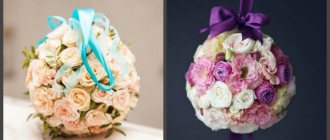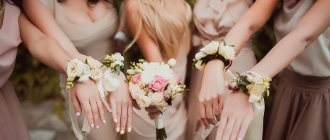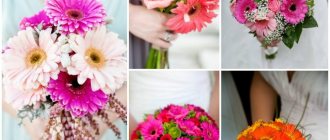DIY paper bouquet for the bride
To make one, you need to take a stamp with the image of a butterfly. Dip it in ink and make impressions on scrapbooking paper. Cut out these blanks and coat the reverse side with glue. Now you need to cut about 30 cm of wire with wire cutters and place it on the back surface of the butterfly, and attach a piece of paper on top. Then the connection point will be hidden.
Glue decorative elements here, such as rhinestones, beads, ribbons, organza. Make some butterflies. Take the wire with which they are attached and insert it into the tube, and twist the ends of the wire and secure with tape. Wrap the ribbon around the tube so that the bouquet handle is as thick as intended.
The next bouquet will never wither either. To make it, you will need:
- artificial flowers;
- tape;
- satin ribbon;
- wire;
- hot glue gun;
- 80 different brooches;
- pliers.
If the brooches are not new, they must first be cleaned and rinsed, then dried. Such products can be cleaned well with a toothbrush and soap.
You need to attach a wire to the brooches, which will become a stem.
Now you need to work on each stem and wrap it with tape.
Disassemble the artificial flowers and remove the petals. Apply a little glue to the two and glue them to the brooch. In the same way, attach a pair of petals to each brooch. Now take five of these blanks and put them together, and then rewind them with tape. Then again you need to attach the following similar blanks; you can put paper flowers here that have wire legs. The bouquet should be semicircular. Now trim the stems so that they are the same length.
Wrap a satin ribbon around the common stem to decorate this part. Secure the tip with decorative pins. You can also use a glue gun and decorate the bouquet with beads.
A bridal bouquet made of satin ribbons will also remain fresh throughout the evening. And if the fun lasts for several days, such a composition will be simply irreplaceable.
You will create it if you take:
- satin ribbons;
- canvas or canvas;
- handle;
- foam ball of the required diameter;
- lace ribbons;
- beads;
- beads;
- artificial flowers;
- threads
Take a compass and draw a circle on the selected canvas.
Fold the edge of the satin ribbon and sew it into the middle of the cone. Then lay the tape, turning it 45 degrees, and secure with threads.
In the same way, bending the ribbon, cover the canvas or other dense fabric further with a satin ribbon.
When the entire base is covered, trim off the excess ribbon, fold the edge over and sew it on. Make several roses, glue them onto a foam ball, and fill the space between these elements with beads and other decorative items.
If you are captivated by this topic, then you can further expand your knowledge in this area by looking at how to make a bouquet for the bride with your own hands.
If you love peonies, then the first story is for you:
If you want to make a bouquet of satin ribbons in blue, then the second plot is for you. This composition is suitable, for example, for a wedding in a nautical style.
How to use
The flowers of the plant are not used in floristry. Greenery is used in the bride's bouquet with eucalyptus. The plant comes in different types.
- Robusta. Florists appreciate the large green leaves of this plant, which perfectly highlight any ensemble.
- Cineria is valued primarily for its foliage—gray, heart-shaped leaves on the branches.
- Populifolia is covered with leaves of unusual shape - from round to elongated.
- Baby blue cannot be confused with another plant; its rounded leaves are arranged in a spiral.
- Nikoli is distinguished by elongated long leaves that add elegance to the composition.
- Ganna has medium-sized leaves and looks very neat in a flower arrangement.
- Light-colored parvifolia adds splendor.
Varieties and types used by florists
Daylilies are bulbous herbaceous plants. Height varies from 0.2 to 2.5 meters. The leaves are whorled, lanceolate, weakly expressed, and in some hybrids they are almost absent. There are about 100 wild species, more than 3 thousand bred varieties, growing in North America, East Asia, and the highlands of India.
About 30 varieties are grown for decorative purposes. Inflorescences contain from 2 to 40 flowers, collected in the form of a brush, umbrella or panicle. Opened buds are:
White Rose
The standard wedding color is white because it symbolizes the purity and purity of the girl. Of course, now moral values all over the world are changing dramatically, and conservatism is fading into the background, but traditions are still preserved and are carefully carried from generation to generation.
A wedding bouquet of white roses is an excellent choice, because light buds look extremely delicate, delicate, sensual, and noble. Even if the celebration is held in a marine or forest theme, you still won’t go wrong if you give preference to a bouquet in milky beige tones.
Of course, florists complement the accessory with beautiful green leaves. The most popular type of bouquet today is cascading flowers, where bright, rich ivy or enchanting lilies smoothly fall down, creating an original ladder.
Roses are such versatile flowers that they harmonize perfectly with any plant. For example, a white bud goes perfectly with blue speedwell, blue statice, orange hypericum, green monstera or yellow solidaga. Those who want to add some color to their decor can resort to drastic measures - painting light roses in any color. As a rule, brides often choose shades such as blue, peach, emerald, and lilac.
Florist advice
In your choice, you should not ignore the recommendations of professionals. Even in salons where flowers and bouquets are sold, real specialists can help you with advice.
- As mentioned earlier, the color of the bouquet depends on the color of the wedding dress. But this does not mean that the flower arrangement should be the same tone as the dress. The ideal wedding bouquet is a bouquet that is one or two shades darker than the wedding dress.
- If after the wedding ceremony you are planning a long trip around the city, taking photographs, or simply the circumstances are such that you need to carry the bouquet with you for a long time throughout the whole day, then using a special capsule or porta bouquet holder with floral foam will help preserve the freshness of the bouquet.
- In order for flowers to fit perfectly into the wedding ceremony, they must be combined not only with the image of the bride, but also with the groom’s boutonniere. Thanks to such a seemingly trifle, an absolutely complete and amazing image of the newlyweds will be created.
- A short bride in a dress with an A-shaped silhouette should choose a round bouquet. In this combination, the bride and the bouquet will look very harmonious.
Slender and tall girls should pay attention to the cascading form of the flower arrangement, in which some of the flowers seem to fall out of the bride’s hands and resemble a waterfall descending from her hands. For short brides in a dress with a straight cut, a vertical mono-bouquet, the so-called wand of flowers on long stems, is suitable. This look looks elegant and laconic at the same time.
- A frame-shaped bouquet is for those who like to experiment. From the frame you can make any shape of a bouquet: a butterfly, a heart hat. And attach cut buds and petals to the frame. Ideal for lovers of everything unusual, those who like to surprise others.
- Truly extravagant girls, whose dress style allows them to use a bright bouquet, can complement it with dried fruits, succulents and wild flowers. Bunches of rowan berries, sprigs of berries, cornflowers, and bells can add special beauty to a flower arrangement.
If the bride is afraid of the discomfort that wearing a bouquet can bring her, then you should turn your attention to a bouquet-bracelet, which is attached to the hand using special ribbons and does not cause inconvenience. In a delicate bouquet on long stems using greenery and wild flowers, it would be very appropriate to use a rope rather than a satin ribbon. Such a bouquet will greatly refresh the bride’s image and create a wonderful atmosphere for those around her.
To learn how to put together the perfect bouquet for the bride, watch the following video.
Varieties of lilies
Lily curly martagon planting and care in open ground propagation photos of species and varieties
Beginning gardeners and those who are not going to devote a lot of time to caring for flower beds should pay attention to unpretentious varieties of lilies. As a rule, they have no aroma, but their decorative qualities are excellent.
- Alaska
- Asian hybrid. Height 90-100 cm. The flowers are star-shaped, directed upward, white, with sparse specks in the center and a yellow spot around the nectary. The filaments are greenish-white. Diameter 15-16 cm. Blooms in July.
- Salmon Classic
- LA hybrid. Height 80 cm. The flowers are cup-shaped, directed upward, pinkish-orange in color with a darker center. It blooms in mid-July, when planted in spring - 70 days after germination of the bulbs.
- Barcelona
- Asian hybrid. Height 80 cm. The flowers are red with a yellow center, medium-sized, directed upwards. It blooms very profusely in June-July.
- Apricot Beauty
- Asian hybrid. The variety was obtained in 1964 in Holland. The plant is 60-70 cm high. The flowers are about 15 cm in diameter, goblet-shaped, directed upward, apricot-orange, a very beautiful shade, with cherry specks. The variety grows well and is disease resistant.
- Geneve
- Asian hybrid. Height 69-80 cm. The flowers are pale pink, goblet-shaped, with a darker center and sparse specks at the base of the petals. Pointed upward. It blooms in July and grows well.
- Lollypop
- Asian hybrid. The height of the plant is 70 cm, the flower is star-shaped, directed upward, about 15 cm in diameter, with bright pink tips. It blooms earlier than other lilies of the group, when wintering in open ground - in June. Prefers sun. A spectacular and unpretentious variety.
- Landfill
- Asian hybrid. Height 70 cm. Flowers are tubular, directed upward, dark purple, almost black. Blooms in July. A very impressive variety for flower beds, can be used as a basis for exquisite color combinations.
- OrangeArt
- Tango-Asian hybrid. Height 110 cm. The flowers are bright orange with thick dark speckles, merging closer to the center into solid brown “scorch marks”, directed upwards.
- Fata Morgana
- Asian hybrid. The plant is 90-100 cm high. The flowers are cup-shaped, looking up; bright yellow with dark specks. Double flower, diameter 17 cm. Racemose inflorescences. Blooms in July. Forms a spectacular, abundantly flowering thicket, very good for flower beds.
- Chianti
- Asian hybrid. Plant height is 90-120 cm, the flower is 8-15 cm in diameter, goblet-shaped, opens wide, directed upwards. The petals are pale pink, delicate in color. It blooms profusely in July or 90 days after planting and grows well.
Options for a wedding bouquet of lilies
Lilies in flower arrangements can be combined with other flowers, either as a solo or as a background. Wild or noble, buds and flowers help to add additional dynamics to the composition, as well as additional symbolism. However, those that are composed exclusively using lilies of one or several colors are especially tender and harmonious.
Mono bouquet of white lilies
A composition in which there are only white flowers is a particularly solemn option. This bouquet is perfect for any wedding dress. Make a mono bouquet with your own hands:
- Trim the stems (stem length - 20 cm), arrange the flowers in a bouquet (leaves down, flowers on top) so that you end up with a round shape. Tie tightly.
- If the leaves are too long, trim them so that they are only slightly visible against the background of the flowers.
- Spray the finished composition with glitter spray.
- Using clear glue, attach decorations (beads, butterfly, crystals, decorative stones) directly to the petals.
- Tie the stem with a ribbon in pastel colors, such as beige or pink. Tie at the side with a bow.
Bouquet of lilies and chrysanthemums
A bouquet with chrysanthemums woven into it in addition to lilies is also symbolic. These flowers represent nobility, deep aesthetic experiences, and love among different nations. The snow-white composition will be diluted by interspersing small flowers, which will make it more dynamic, soulful, and not so pretentious. To add tenderness to the image of the bride, they are woven into the lower tier, leaving the central part in the possession of lilies. Such bouquets will look good with various decorations: sparkles, ribbons, decorative nets, crystals, background flowers.
Wedding bouquet of lilies and roses
A bouquet made with roses and lilies is the most popular combination used at weddings. They match each other well: delicate, feminine, and come in many colors and varieties.
- Pink roses against the backdrop of snow-white lily grace look especially advantageous, shading the bouquet and adding the missing pastel palette to it.
- White roses go perfectly with pink lilies: if you decorate such a composition with a bunch of decorative pearls and apply glitter, such a bouquet will look incredibly delicate in the hands of the bride.
- Both types of delicate pink flowers go well together if their tone is slightly different and the bride is dressed in a white or cream outfit.
How to make a bouquet of lilies and gerberas
Lilies and gerberas in wedding transcription look good together if the composition has the shape of a ball. To create such beauty you need the following:
- Prepare lilies for storage. To prevent the flowers from fading, immerse them in water with sugar and aspirin and keep them there for a while. The aroma will remain after this procedure, but the buds themselves will be saturated with water, becoming more elastic.
- Prepare a porta-bouquet base. Its design is shown in the photo.
- To do this, place a special pad (“oasis”), saturated with water, inside its mesh - the flowers embedded in it will last longer. Attach the upper part of the portaquet to the lower part with wire. Wrap the lower part with double-sided tape and veil it with aspidistra leaves.
- Secure the leaves with the lower tier, sticking them into the oasis, then place flowers in a circle.
- Add greenery, decorative twigs, small background flowers, beads, sparkles, crystals - everything that will give your bouquet elegance and shine. Complete the look with glitter spray.
- Decorate the leg of the porta bouquet with a ribbon or bow. Artificial details should not be visible after decoration.
Lilies for a bouquet: combinations, shades, how to arrange
Flowers, like people, have their own characters. When composing a wedding bouquet, you should take into account the image of the bride herself. For sophisticated romantic natures, a bouquet of lilies is more suitable. These flowers are distinguished by sophistication, tenderness and elegance.
Lilies are distinguished by sophistication, tenderness and elegance.
Lily is called the princess among flowers. It is also considered a symbol of the French kings. In the Slavic tradition, the lily symbolizes girlish charm and innocence. This is the favorite flower of mermaids, which was also credited with magical powers. The rhizome of the lily was carried in an amulet near the heart as a talisman.
Christian tradition saw in this flower a symbol of devoted love. Lily is often used to create wedding bouquets. It is especially appropriate in cases where both the bride’s outfit and accessories are decorated with lilies.
Classification by style
Modern floristry distinguishes several basic styles, thanks to which it is possible to create the ideal bouquet for any life event.
Vegetative style
The vegetative composition is a complex, skillfully assembled bouquet that looks as natural as possible and close to natural conditions. Very often it is called a piece of nature, since its creation not only uses natural materials, but also takes into account the basic characteristics of the plant world.
When creating a vegetative bouquet, pay attention to the following factors:
- Asymmetrical and symmetrical arrangement of plants;
- Grouping, proportions and examples of growth in the natural environment;
- Natural color and shape of plants;
- Seasons - seasonality allows you to understand what materials should be combined.
This composition is minimally decorated, but despite this, it looks incredibly stylish and elegant.
Decorative style
Decorative style allows you to create bouquets in a single concept, sometimes from completely dissimilar materials. In this case, the plants lose their individuality, but this is more than compensated by the overall expressiveness of the bouquet.
The features of this style are the following:
- Plants should fill the bouquet tightly to the center;
- Both asymmetry and symmetry are allowed;
- Various natural and artificial materials are used and grouped together in the work;
- Color contrasts are used because color is very important in composition;
- It is allowed to combine stylistic features of different eras;
- Overall visual balance is maintained.
This style is quite bright and convenient to perform, so many florists prefer to use it in their work.
Shape - linear style
Contours, line and shape are the main elements of the form-linear style. They set the tone for the entire floral composition. In this case, an important condition for the work is such a combination of elements in which the bouquet will acquire expressiveness.
This style has the following characteristics:
- The use of many shapes and lines is not allowed;
- The form must remain clear;
- To create a bouquet you need a minimalist amount of material;
- The arrangement of the material should be asymmetrical, although symmetry is sometimes allowed;
- A combination of plant and artificial materials;
- Contrasts and juxtapositions are used;
- The bouquet should maintain space.
Bouquets in this style are very suitable for interior arrangements and various conceptual events.
Massive style
One of the clear and understandable compositional styles is the massive style, which is also called style-form. The execution of these compositions is quite simple, but at the same time labor-intensive. The shapes of the bouquets are clear, for example, a cone, a heart or a ball, the main thing is to decide on the execution technique.
To assemble massive bouquets, you can use various techniques, such as arrangement on a base, gluing, weaving, parallel or spiral assembly, and others.
In addition, when using a form style, the following is recommended:
- It is advisable to use no more than 3 types of material;
- The composition does not need a center, so the bouquet must be filled tightly;
- When assembling, you must adhere to a strictly chosen form;
- If the bouquet involves a base, for example, a vase, then it should be compositionally combined with the bouquet.
It is worth additionally noting that the development of styles does not stand still and modern floristic schools have recently sought to highlight new directions, one of which in the near future may become a transparent style.
What to consider when composing compositions
To make the bouquet delightful and appropriate for the occasion, it is advisable to adhere to the following rules:
- Consider the gender of the person for whom the composition is being compiled. Women's bouquets have a round shape, while men's bouquets have an elongated shape. The size of the composition varies and depends on the occasion.
- When composing a bouquet, follow the combination of colors of the buds. In this case, use no more than three shades. Red or yellow tulips will not look good with purple lilacs. It is better to use white and pink tulips when composing the composition. They will help create a delicate spring bouquet. A successful addition to such a composition would be sprigs of white or lilac hyacinth. Such a bouquet framed in a soft pink mesh will cause admiration.
- Be careful when selecting plants for your composition. Some of them are incompatible and suppress each other. Make compositions from plants that are loyal to each other. Then the bouquet will remain fresh for a long time and delight others.
- It is important to properly prepare the material before making a composition. To do this, you need to make oblique cuts on the stems, place the plants in water for several hours and then form a bouquet.
- Any material that matches the general concept of the composition is suitable for decorating a bouquet. It is important not to overload with all sorts of additional details and remember that decor is used only to add completeness and style.
Wedding mono-bouquet of white lilies
Green-white or cream shades are selected for compositions. With a stem length of at least 20 cm. The bouquet requires 3 branches with several open and closed buds:
- The prepared branches are cleared of leaves.
- Cut the stems with a floral knife at an angle of 45 degrees.
- Arrange the stems in such a way that the opened flowers are viewed outward, and the buds are located in the center.
- Add aspidistra greens around the edge.
- They are firmly fixed so that the bouquet does not move apart or fall over.
- Beads, crystals, and decorative stones are attached to the petals of the opened buds using glue.
- Decorate the attachment point with a light-colored ribbon.
Lilies for a bouquet: combinations, shades, how to arrange
Lilies are luxurious flowers with large buds, delicately curved petals and a refined aroma. This plant occupies a special place in floristic art. Delightful bouquets are collected from lilies, suitable for giving on any occasion and for no reason. Every person will gladly accept such a bouquet.
In the article we will tell you who is appropriate to give lilies to, what color, how many pieces to choose depending on the situation, varieties of lilies, what flowers are combined with lilies in a bouquet, tips for designing a composition.
Lilies in floristry
Bride's bouquet of lilies.
This is not to say that a lily is a simple flower. Like any girl, he requires a special approach and care. An additional advantage is its classic white color, which matches perfectly with the bride's dress.
Before choosing this flower for your own bouquet, you need to think and find out what features it has. In this case, you will begin to understand whether a flower plant is suitable for your celebration or not.
A specific smell - you need to be prepared for this. Everyone knows that lilies are distinguished by the fact that they have a sharp and persistent aroma. Not long ago, breeders developed a new variety of lilies that has no smell at all. For a wedding celebration, you need to purchase exactly this option. If you like the smell of lilies, then still try to buy a flower without a scent. The bride will be with the bouquet all day. The aroma will slowly but surely poison her. As a result, the girl will not even notice how by the end of the day she will begin to experience severe headaches.
Pay attention to the size of the bud. Fortunately, the plant has many varieties that differ favorably from each other in the size of the inflorescence. Some of them are suitable for a bouquet with large royal roses, others will look good with dwarf roses.
Lily is a very delicate and fragile flower. This manifests itself not only in its appearance. The slightest crease can immediately denigrate the plant
Thus, the girl needs to be careful not to damage her bouquet. He will not tolerate rude treatment
You need to be very careful with him. A wedding bouquet can last up to 3-4 days, which in the flower world is considered quite a long period.
The stamens of the flower itself are brightly colored, which, if handled incorrectly, can turn a wedding dress yellow. Therefore, be careful and careful.
What plants are suitable?
Types of flowers suitable for the bride's bouquet:
- roses - require pruning of thorns;
- peonies - June wedding;
- chrysanthemums - combined with small bright flowers, good in winter;
- hydrangeas - ideal for a spherical bouquet, as well as a winter option, they have bright colors (blue, pink, purple);
- ranunculi (orange, pink, white) - combined with roses, peonies, lilies;
- eustoma - for tulips, roses;
- orchids - for cascading mono-bouquets and in an ensemble with greenery;
- calla lilies - as an addition to bright small flowers;
- lilies - choose a variety without a strong odor;
- carnations - to dilute the snow-white bouquet;
- gerberas - will give unusually bright autumn colors;
- freesia is an aristocratic flower;
- anemones – arrangement option with freesia;
- dahlia - for a bright autumn wedding in country style;
- tulip - bloom quickly;
- wildflowers as an addition - daisies, mallow, jasmine, cornflower, forget-me-not;
- greens: salal, ruscus, eucalyptus, aspidistra leaves, ivy, fern.
White peonies and soft pink roses go well together. A bouquet of blue and purple airy hydrangeas is extremely beautiful. At a spring wedding, tulips in mono-bouquets and lilies of the valley look great; in the fall, a lush range of colors and a riot of bright colors of dahlias and chrysanthemums look great. Roses are good all year round. And for a summer wedding, preference is given to a bouquet of callas, orchids and lilies.
What colors does a lily go with in a bouquet?
Lilies are very beautiful flowers that look perfect when put together on your own. But bouquets that combine these delicate fragrant plants with other types of flowers look no less impressive.
What flowers go harmoniously with lilies:
- orchids;
- phlox;
- irises;
- bells;
- chrysanthemums;
- bush carnation;
- peonies;
- chamomile;
- jasmine;
- delphinium;
- fern leaves.
Lilies have large buds, so they are best combined with flowers with small inflorescences.
The final stage: packaging
For quite a long time, no special importance was attached to the design of packaging for bouquets of fresh flowers; its role was played by transparent cellophane. Later, packaging made of bright corrugated paper, fancifully decorated with prints and scallops, and complemented with floral mesh, became a sign of good taste.
Peonies in craft paperSource flowerbulbs.nl
To date, there has been a trend towards the use of more discreet and sophisticated packaging for flowers; Florists know how to properly arrange a bouquet. They offer a lot of interesting materials. The following options are common:
Paper. Paper packaging is still in trend due to its practicality and variety. It can be monochromatic, with thematic patterns and reliefs; Kraft paper is gaining popularity. Texture types are interesting: corrugated, waffle, crinkled, crepe. Korean packaging (tracing paper) is becoming popular, which does not wrinkle and gracefully deforms around the bouquet.
Corrugated paperSource prom.st
Fabrics. Elegant and soft artificial linen goes well with any floral arrangements. Rough jute burlap made from natural raw materials is suitable for exotic flowers. Floral felt, light and moderately dense, is suitable for both voluminous, tall bouquets and small buds.
Bouquet in burlapSource wallbox.ru
With an ear of cornSource flowerray.rf
Synthetic film is still popular. It is varied in texture and not only decorates the bouquet, but also maintains a humid microclimate, and also protects the flowers during transportation.
Black kraft paperSource pestro.by
Sometimes you have to create packaging from what you have on hand
Stylish options include packaging that does not distract attention from the bouquet and has a slightly careless appearance. If you don’t know how to beautifully pack a bouquet of flowers, opt for craft or Korean paper
You can pack one rose beautifully using tissue paper (tishyu). If you are familiar with the recipient's tastes, perhaps an unusual option: an old sheet of music or a magazine sheet will do.
In pink paperSource photostockeditor.com
About fashionable packaging methods in the following video:











